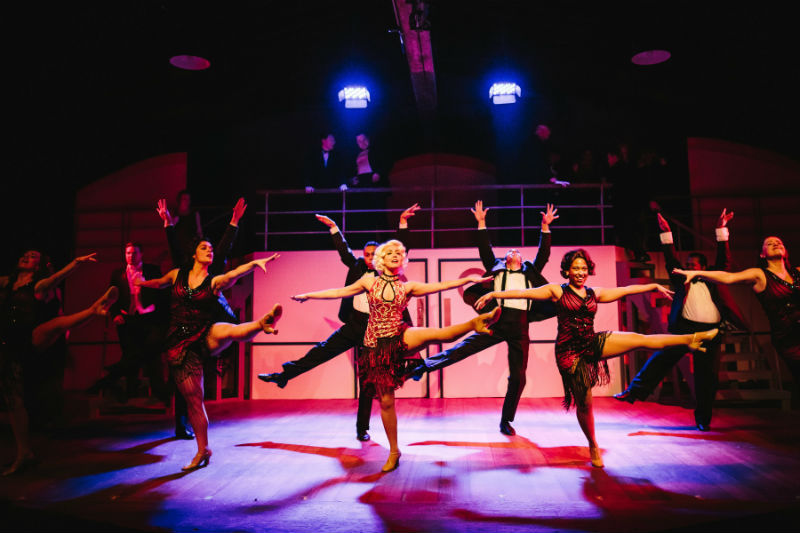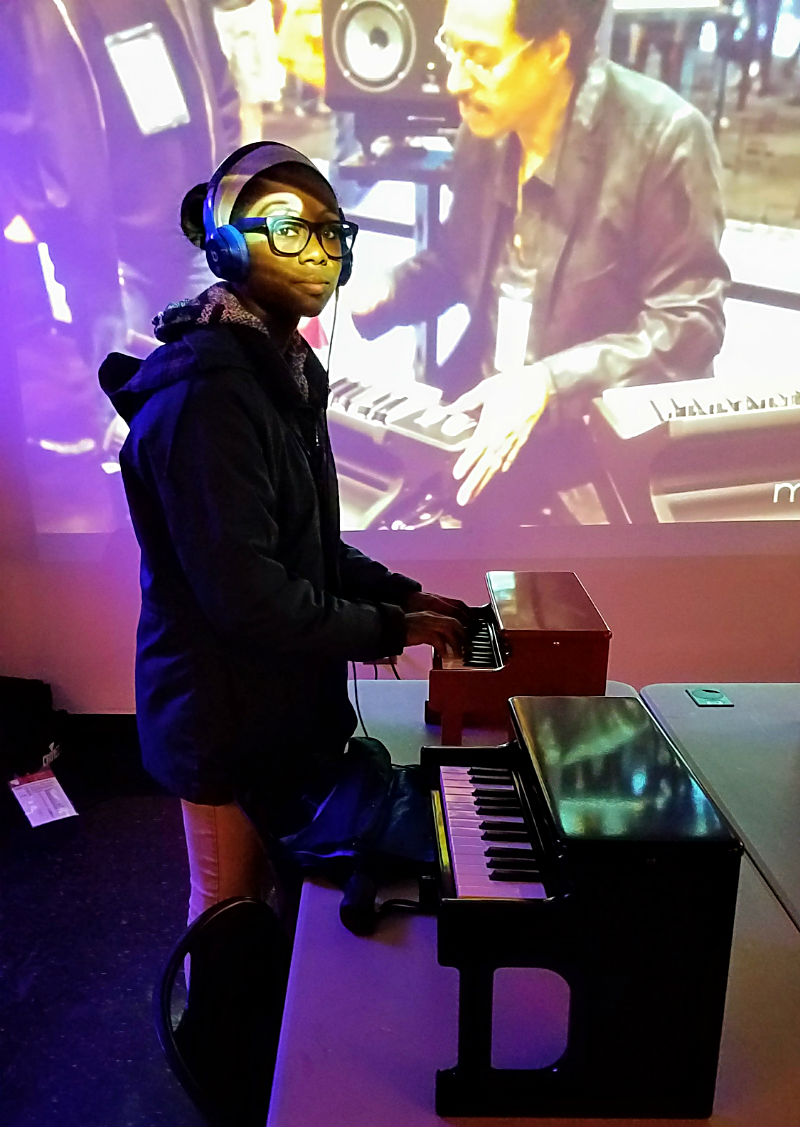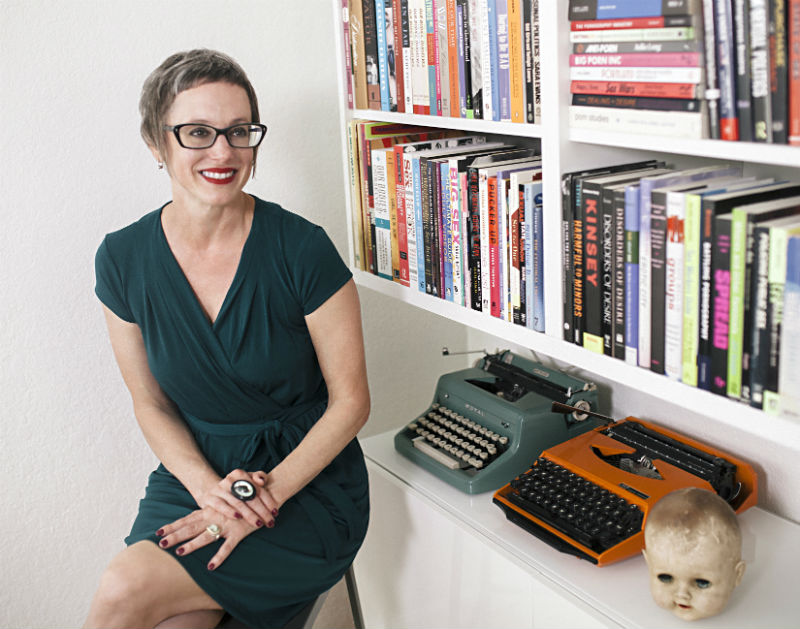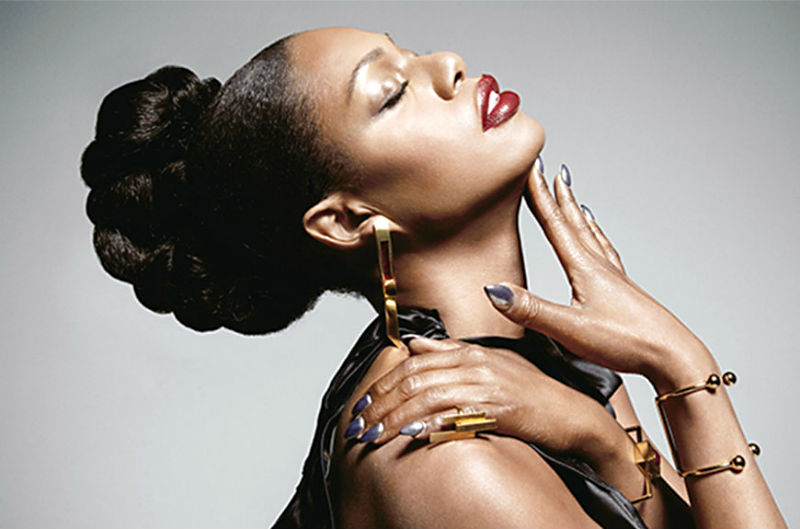Mash-Up 'Mime: Theatre Nova's "The Year Without a Panto Clause"

Around the holidays, theater troupes often feature classic Christmas plays familiar to Americans. But for the past two years, Ann Arbor’s Theatre Nova has presented an American twist on a British Christmas tradition. A panto, short for pantomime, is a variety show that developed in England in the 18th century that employs song, dance, comedy, and much more to tell a Christmas-related story.
This year’s panto, The Year Without a Panto Clause, is written by Theatre Nova artistic director Carla Milarch and features original songs by the show’s music director, R. MacKenzie Lewis, who has composed music for Nova's previous two pantos as well as for last year’s hit musical Irrational.
I spoke with Milarch about the inspiration for her pantos and what makes this show unique.
Q: For readers that may not be familiar with the panto tradition, would you explain what different activities make up these performances?
A: I always describe a panto as a mash-up of a musical comedy, stand-up comedy, a vaudeville act, and an old-fashioned melodrama, with a heaping helping of The Three Stooges thrown in. There's a good deal of falling down, chases, booing the villain, cheering the hero, political humor, and jokes -- and, of course, candy for the kids.
Q: Theatre Nova has put on a panto for their holiday show for the last two seasons. Whose idea was it to showcase an art form that is rarely seen in the U.S.?
A: It was Emilio Rodriguez's (of Black and Brown Theatre and now UMS). He had seen a panto in Los Angeles and suggested it.
Q: How do you get the ideas for each show, and specifically, how did you come up with the story of this year’s show?
A: A traditional panto is based on a children's story, usually a fairy tale. In Britain, they do Cinderella, Jack and the Beanstalk, and Dick Wittington and His Cat, among others. We wanted to put an American twist on ours, so we decided to narrow it down to Christmas stories that Americans would be familiar with. So far, we've done a twist on Rudolph (An Almost British Christmas), The Nutcracker (Sugar Plum Panto) and now The Year Without a Panto Clause.
Q: Can you talk a little about your collaboration process with R. MacKenzie Lewis? Does Lewis write some of the music for the shows?
A: Between our theater gigs and our kids, Lewis and I are some of the busiest people I know. So, we do a lot of work remotely. I come up with lyrics and ship them off to him; he tweaks them and writes the music and ships them to the actors. They learn them and I eventually hear them. It's unusual because I trust him so implicitly that I know whatever he does I will love. I literally have not heard some of the songs he's written for the show yet, but I know they will be fantastic!
Q: Do you both pick the popular songs that will be included in the narrative or does Lewis do it all himself?
A: I actually pick the popular songs as I'm writing the play because, usually, the inspiration for what's needed will hit me in the moment.
Q: During every performance of the show, there will be a different special guest performer who will be a small part of the variety act portion of the panto. Is this something unique to Nova’s pantos, or did this originate in England as well? Can you tell us some of the guests you’ve had in the past, and give us a preview of who we might expect this year?
A: This is all a part of the panto tradition. We have wonderful special guests this year. We're bringing back crowd favorites Gemini and magician Jeff Boyer as well as a lot of local theater folks you'll recognize from shows at NOVA and around town. I'm hearing rumors that Santa himself might make an appearance at some point in the run (the REAL Santa, not the one in the show!)
Q: What can audiences expect from this year’s panto, and what are you most excited for them to see?
A: The thing that I'm excited about the most this year, is that I think that this panto, in particular, holds up more as an actual play than the previous two. A panto is a very specific style, with lots of stuff in it that isn't your typical theater fare. In both past years I think we've been successful at creating a show that appeals to young kids, with lots of falling down, zaniness, etc. I've even had some Brits tell me it was "just like home!" This year, I think the play, although it maintains all of the zaniness, trust me, also has a thread of a touching and heartfelt story that is genuinely moving and carries you along in the more traditional theater vein.
Q: Is there anything else you’d like to say about this panto?
A: The premise of the play is that 2017 has been a bummer of a year, and Santa, like many of us, is starting to feel too depressed to carry on with life as usual. So, he decides to cancel Christmas. Jingle and Jangle the elves then set off on a hilarious journey to parts hither and yon to find some Christmas spirit to get Santa back in the saddle. Hilarity, zaniness, and musical comedy ensue. But I think at the core of the play is the genuine question we all feel of how we find hope in the world today. I think the play will give the audience some hope, but at the very least we'll give them a much-needed respite and a chance to laugh at our troubles, dance our cares away and focus in on the true spirit of the season. I'm happy with the way it turned out. I think audiences will be, too.
Emily Slomovits is an Ann Arbor freelance musician, theater artist, and writer. She plays music with her father and uncle (aka Gemini) and others, is a member of Spinning Dot Theatre, and has performed with The Encore Musical Theatre Company, Performance Network, and Wild Swan Theater.
“The Year Without a Panto Clause” runs Dec. 1-31 at Theatre Nova, 410 W. Huron St., Ann Arbor. For tickets and more information, visit theatrenova.org.
It's De-Lovely: "Anything Goes" at Encore Theatre

“Tap Your Troubles Away” isn’t one of the songs featured in the screwball musical comedy Anything Goes, but it’s nonetheless what popped into my head upon leaving Dexter’s Encore Theatre on Sunday.
Why? Because this silly confection of a Depression Era, vaudeville-infused musical, jam-packed with wordplay and witty Cole Porter tunes, offers a pleasurable, two and a half hour escape from our increasingly stressful world.
Originally staged in 1934, with a new book by Timothy Crouse and John Weidman (original book by P.G. Wodehouse and Guy Bolton, and Howard Lindsay and Russell Crouse), Anything Goes tells the story of Wall Street broker and ladies’ man Billy Crocker (Sebastian Gerstner), who stows away on his boss’ cruise liner upon spotting the woman he truly loves, heiress Hope Harcourt (Emily Hadick), on board with her British fiancee, Lord Evelyn Oakley (David Moan). Hope’s family suffered great losses during the Crash of ’29, so her engagement is more pragmatic than romantic, and her heart secretly belongs to Billy. Meanwhile, brassy nightclub singer Reno Sweeney (Olivia Hernandez) only has eyes for Billy, too, but over time, an unlikely friendship grows between her and Oakley.
Oh, and there’s a scheming, wisecracking gangster-in-hiding (Moonface Martin, played by Dan Morrison) and his moll (Erma, played by Elizabeth Jaffe) because isn’t there always? Some featured Porter songs in the show (besides the title number) include “I Get a Kick Out of You,” “You’re the Top,” “It’s De-Lovely,” and “Blow, Gabriel, Blow.”
The latter number is one of the production’s best and most extensive showcases for Rachel Constantino’s joyous choreography, the other being the first act's energizing closer, “Anything Goes” -- which, amazingly, winks at one of the biggest dance men of the show’s era, Busby Berkeley, in its patterns and formations, despite the Encore’s relatively tight space limitations.
But the big, splashy, “tap-gasm” (my term) numbers weren’t the production’s only highlights. “The Gypsy in Me” comes off as both hilarious and sexy, with Moan and Hernandez turning up the fizzy flirtation factor through Constantino’s cheekily sensual choreography; “Buddie, Beware” has Jaffe literally rolling in men; and in “Friendship,” Hernandez and Morrison break the fourth wall by acknowledging that they can’t keep musical director Tyler Driskill vamping forever while they neurotically commiserate and kvetch about various things.
These moments epitomize the Encore production’s polished, sophisticated breeziness, as established by director Thalia Schramm, who keeps the pace clicking without ever making the scenes feel rushed. Plus, Schramm subtly, wisely downplays the culturally cringey parts of the show -- namely the often-exaggerated depiction of a reformed Chinese gambler -- while still honoring the script. Now, how one man’s outfit comes to disguise two characters, well, that’s the kind of musical theater math you have to just roll with.

Driskill’s seven-person orchestra delivers Porter’s glamorous score with panache, and the ensemble sounds divine. Tyler Chinn’s lighting design helps bring out the romance and heat of certain numbers, while Kristen Gribbin’s versatile sets, paired with Anne Donevan’s props, help to visually transport us to the SS American while also allowing for seamless, quick transitions. Finally, Sharon Larkey Urick’s handsome costumes manage to be bewitchingly sexy without being tacky, with Hernandez sporting the production’s most gorgeous gowns.
But Urick’s dresses are only one reason it’s hard to pull your eyes from Hernandez whenever she’s on stage. The charismatic actress commands the stage with a winning charm, and her knockout vocals have an effortlessness that’s only achieved through hard work and discipline. Gerstner is a delightful, graceful, and appealing leading man, and Morrisson and Jaffe have a ball with their deliciously cartoonish supporting roles. One of the most impressive leaps, though, is achieved by Moan, who takes the stuffy straight man role and renders it hysterical by seizing upon every opportunity -- like Oakley’s fascination with American colloquialisms, for instance, or his penchant for dancing around in a short robe and sock garters (courtesy of Urick) -- to wring humor from the character, and thus make Oakley more interesting.
Of course, there’s no mistaking that Anything Goes is a show built around the music, not the other way around; and with its absurd plot, cornball humor, and broad characters, the musical is more about making audiences feel good for a couple of hours than it is about making them feel much of anything else.
But these days, I’ll happily take that.
Jenn McKee is a former staff arts reporter for The Ann Arbor News, where she primarily covered theater and film events, and also wrote general features and occasional articles on books and music.
"Anything Goes" runs through Dec. 23 at The Encore Theatre, 3126 Broad St., Dexter. Showtimes: Thursdays, Fridays, and Saturdays at 7:30 pm and Saturdays and Sundays at 2 pm. Visit theencoretheatre.org for tickets and more info.
Look Deep: John Lilley's “Wandering Around … in black and white” at Kerrytown Concert House

We last saw John Lilley’s photography at the Kerrytown Concert House in June 2012. His John Lilley Photographs exhibition found the Dexter photographer using digital color notable for its exhilarating chromaticity as well as its remarkable penchant for detail.
“Simply put,” said Lilley at that time, “I make photographs because I see photographs.”
But as he later tellingly added in that statement, “I’m rarely attracted to the 'big picture.' Rather, my vision is almost unconsciously drawn to distinct designs, textures, and forms that occur as small subsets of the broader landscape. I’m fascinated by the myriad possibilities for abstract composition that exist in our world.”
All of which is to say that Lilley’s current Wandering Around … in black and white shows us that his monochromatic photography is easily the equal of his color work. Indeed, if anything, Lilley’s photographic self-discipline is as much (if not more) vivid than his color art.
The work in this exhibit dates back to the 1970s, from using old-school analog photographic technology right up through contemporary digital work recently executed. None of the photos are dated, which creates a chronological ambiguity that forces the viewer to focus on the art rather than try to trace Lilley’s artful development. This strategy effectively makes each work an equal among equals.
As he says in his most recent gallery statement:
The American Road Trip is, for me, the activity of simply wandering from place to place. I’m not sure if the road trip is an excuse for photography, or if photography is my excuse for the road trip. Whichever it is, the traveling about is an opportunity to see what’s out there, to discover new places and the things that inhabit those places and spaces. When I’m on the road with my cameras I’m totally focused on the undivided landscape. I try to see into that landscape as deeply as I can.
Right said: What’s best about this self-description is that this “seeing” is precisely what Lilley does best. And how he sees -- as much as what he sees -- is what makes his exhibition a superior display of art.
This may be because black and white images tend to appear ageless. There’s often a subtle chiaroscuro tincture that ironically reveals more nuance than the color we would normally see around us. This monochromic shading makes it difficult to date the work because of the composition’s play of light and shadow.
As such, black and white photography is often more dramatic than color photography because of this psychological remove. There’s a nebulous gravity running through the photographs in Wandering Around in Black and White that contrast heartily to the vibrant color patterns of Lilley’s color photos.

Likewise, it’s interesting that one of the more stunning works in the 25 photographs on display is magnificently large-scale if there ever was a “large-scale.” Because for someone who says he’s not looking for the “big picture,” Lilley’s Devils Lake, North Dakota sure looks big enough.
Photographing an aged building next to a silo, Lilley’s Devils Lake is simultaneously a big picture and nuanced study. Shrewdly referencing a touch of early 20th century American Precisionism, the aged architectural structures in the photograph have a gritty integrity that can’t be missed. Lilley expertly captures these structures rectilinear façade with its complex horizontal and diagonal gradation to illustrate each striated scuff that marks its history.
On the other hand, Lilley statement implicitly references “road trips” and other such places --
and what could be more other than landscape photography? His Sand Dunes, Early Morning: Great Sand Dunes NP, Colorado certainly fits this bill. A striking crosswise depiction of nature in its harsh environment, his depiction of this national park is surprisingly serene for such a terrain.
The vista is grandly impressive -- and there can be no denying this fact -- yet Lilley’s judgment softens the environment’s austerity through the adroit manipulation of light and shadow. Really no more than a series of receding sand dunes whose alternation of light and dark creates an internal harmony of visual alliteration, Sand Dunes, Early Morning's interspersed rhythmic contemplation carries the viewer’s eye well beyond the desert horizon.
Yet perhaps the hardest trick for any art photographer using black and white is to craft silhouettes of such a sharp disparity that the precise tonal juxtaposition supplies the entire information one needs to take the measure of the composition. Lilley’s Wires: Concordia, Kansas is easily the masterwork in the exhibit for this reason.
Wires features a black and white contrast that’s startlingly pure in its monochrome articulation. As inspired as it is spare, two supporting triangles (of whatever origin) suspend a tangle of irregularly coiled curvilinear wire through an eye hook bolt in what amounts to a compositional limbo. Lilley dispenses with any semblance of depth in favor of a paradoxical black and white curvilinear and rectilinear abstraction whose precise difference lets the work’s geometric elements hover on the photograph’s foreground. It’s a satisfying inner tension that allows his viewer’s eye to wander as restlessly as does his camera.
John Carlos Cantú has written on our community's visual arts in a number of different periodicals.
John Lilley's “Wandering Around … in black and white” runs through Dec. 3 at Kerrytown Concert House, 415 N. 4th Ave, Ann Arbor. The exhibit is available 9:30 am-5 pm, Monday-Friday, during public concerts, and by appointment. For information, call 734-769-2999 or visit kerrytownconcerthouse.com.
Synthesize Your Life: A wrap-up of Mini MoogFest 2017

If we Ann Arbor District Library staffers were excited synthesizers, we'd be whooping with pitch-bent, major-key oscillations from the joy Mini MoogFest 2017 brought us. Our third annual iteration of this event greatly expanded upon our two previous offerings, and we had a fully packed house at the Downtown Library on Saturday, Nov. 18. Librarians on the scene estimated that over 350 people -- including around 75 kids -- made their way through Mini MoogFest, where they built synths using littleBits, played around with AADL's Music Tools, and enjoyed live performances from area electronica artists. Below is a roundup of photos, videos, and social media posts covering Mini MoogFest 2017.
Thanksgiving Tradition: Matt Watroba at The Ark

Thanksgiving is all about traditions. And over the last couple of decades, one tradition that has taken root in Ann Arbor is Matt Watroba’s Day-After-Thanksgiving Concert at The Ark.
The well-known Michigan performer, songwriter, and radio host isn’t exactly sure how long he’s been doing the concert on the day after the holiday, but he estimates it’s been about 25 years. It’s become his most popular annual gig, and he knows some families incorporate it into their regular holiday plans.
“It has taken on a real community feel,” he says. “People are actually making it a tradition.”
While the annual show often features some guest performers, this year’s edition will likely be something closer to a solo show -- although he notes, “There’s always the possibility of surprise guests popping in.”
Watroba’s wife, Kim, will sing with him for part of the concert. “It’s awfully fun to sing love songs on stage with someone you actually love,” he says.
Since the audience typically includes some longtime fans, Watroba will try to include some material from all his past albums. And he’ll definitely include a “community sings” component, something that has become a major focus for him in recent years.
The community sings movement encourages regular gatherings of people to sing as a group, regardless of musical ability. Watroba’s involvement began when he conducted a radio interview with folk music icon Pete Seeger, the dean of the movement, aged 89 at the time. At the close of a long, accomplished career in music and social activism, Seeger told Watroba his most important work was getting people to sing for themselves.
“That just astounded me,” Watroba recalls. So, a couple years later, “Living in a country that seems to be more polarized than ever, I got the notion that it was time to take up Pete’s invitation.” He now leads some regular community sings across the region, and he also spends time spreading the word and teaching others how to lead them.
Community sings can include classic folk songs as well as newer songs that can be easily taught. The type of song doesn’t matter; the act of singing together is what’s important. “Everybody leaves feeling better than when they got there,” Watroba says.
Although he’s well known throughout the region as a performer -- both on his own and in partnership with Robert Jones, with whom he’s also creating a new nonprofit called Common Chords -- many fans first came to know Watroba via radio. For more than 20 years, he hosted the Folks Like Us show, primarily on WDET, playing a wide range of acoustic-based music.
Just last month, he returned to the Michigan airwaves: Folk With Matt Watroba now airs 6-8 p.m. Sundays on WKAR in East Lansing, and it can be streamed online at wkar.org.
“It’s really been heartwarming,” Watroba says of the reception to the show. “WKAR has just bent over backward to make it happen.”
He’s committed to always featuring some Michigan artists on the show, and he also includes a calendar of folk music events around the region -- both of which were important features of Folks Like Us. He notes with a chuckle, “That old show had an effect on a lot of people.”
Bob Needham is a freelance writer; the former arts & entertainment editor of The Ann Arbor News and AnnArbor.com.
Matt Watroba plays The Ark, 316 S. Main St., at 8 pm on Friday, Nov. 24. Tickets are $20/$27; a dinner-show combination is also available in conjunction with Conor O’Neill’s for $30/$37. Visit theark.org for tickets and more info.
Midwest Meditations: Cal Freeman, "Fight Songs" at Literati

“This is a lot of people for a poetry reading," said writer Cal Freeman. "I’ve read for three people before.” On Nov. 11, Michigan poet Freeman read from his new book, Fight Songs, at Literati bookstore. The crisp November evening seemed perfect for listening to regionally focused poetry as the temperature made its way downward.
Freeman is the kind of poet I would have spent a semester in a creative writing class peeking at over a copy of the latest student work being workshopped. He’s tall, though not quite lanky, and was dressed in mostly gray. I wouldn’t describe his look as rumpled, but the word crossed my mind. Very Midwestern.
She's Picking Up Good Vibrations: Lynn Comella, "Vibrator Nation" at Literati

When it comes to other adults’ sexual choices, I’m very live and let live. And in my personal life, I’m very willing to make a joke or tell a story laden with sexual innuendo, and I’ve long ago accepted that I’m the person who will robustly fall face-first into a strange double-entendre, I found myself a bit shy at the bookstore when I purchased my copy of Lynn Comella’s Vibrator Nation in advance of attending her discussion of the book which took place on November 14th at Literati.
This book was based on more than 80 in-depth interviews with sex-toy shop owners, employees of said stores, and pornographers. Comella herself worked at Babeland in New York City, which provided her ethnographic access from both sides of the sales counter. Her book synthesizes this and examines the role of feminist sex-toy stores on the larger adult industry.
Why study sex-toy shops?
Comella knew to answer that question for the audience right away.
It turns out that this project began as a part of her graduate coursework. She had taken a field methods class in cultural studies and had an interest in sexual politics. The class required her to conduct a small-scale ethnographic project. She asked herself, "Where are the places that women can be sexual subjects as opposed to sexual objects?" As a part of her work, she spoke with Aileen Journey, the owner of a store called Intimacies, which had just opened in the town where she studied. The owner told Comella that she saw her store as a feminist way to empower women and that she had modeled her store after Good Vibrations, a store that had opened in the 1970s in San Francisco’s Mission District.
Good Vibrations shared the idea that sex education could be empowering and helped Journey on the road to establishing her own store. This help included selling a vendor list for a mere $50 -- such magnanimity is an anomaly in the business world. But it turns out that this, as Comella calls it, “non-competitive ethos” was a reason why some saw the businesses as activism.
In 2008, there was a shift in the adult store industry. According to Comella, before this point, the industry had catered to the perceived desires of stereotypical men. She argues that 2008 was a game-changer due to both the recession and also the proliferation of free Internet pornography. Suddenly, the women’s market became appealing, as it was a rare growth area in the industry. Comella, however, became interested in the history of this already growing market, which had been building since the early 1970s.
Comella read from a chapter in her book titled “Living the Mission,” where she talked about the lived experience of working at Babeland. Here, she says, “Every shift I worked at Babeland put me on the front lines of its mission, which was ‘to promote and celebrate sexual vitality by providing an honest, open and fun environment, encouraging personal empowerment, educating our community and supporting a more passionate world for all.’”
Feminism provided a healthy dose of friction inside of this passionate world. For example, early on, men weren’t allowed into some of these spaces. Joani Blank of Good Vibrations, however, recognized that not all men were comfortable in the more traditional shops and that her store was appealing to some men. These business owners, then, were forced to decide whether or how to include men. Feminism also complicated things, raising the question of how erotic videos fit into the equation. How does one respond to such a market demand when some of the feminist thought behind these shops was anti-pornography? How do shops adjust to the construction of feminism, how do they embrace intersectionality? How do they become trans-inclusive? How do these businesses remain responsive?
There was also the matter of what sort of bedfellows feminism and capitalism made. Some individuals felt that a store, a capitalist enterprise, was antithetical to feminism. Others feared that once the market for women-centered sex shops became viable it would be co-opted and would no longer be about empowerment, liberation, and education. Babeland faced this matter head-on. The store had sold shares to its employees, yet the management still felt like profits weren’t as important as the social work that they provided. The employees, now owners, disagreed.
Comella argues that it’s “easy to think about sexuality as something we own,” but larger forces that act upon sexuality, such as cultural norms and public policy, impact it.
In the Q&A portion of the evening, the audience’s questions pushed at the larger cultural forces. Economic class factored in, as Comella acknowledged. For instance, finding body-safe materials from ethical sources sometimes priced-out certain consumers. She also acknowledged that within the field that storeowners talk a great deal about gender equality and sexuality, but not as much about class or race. This presented her with a challenge; it’s difficult “to write about things people aren’t really talking about.”
In examining this segment of the adult industry, Comella answers many questions about the rise of the business and the circuitous paths that female and queer-friendly sex-positive sex-toy stores have taken. She also begs the question of what happens next within this dynamic trade.
Sherlonya Turner is the manager of the Youth & Adult: Services & Collections Department at the Ann Arbor District Library. She can be found diving headfirst into all sorts of projects over at sherlonya.net.
Glowing Highlights: Laverne Cox at U-M's Center for the Education of Women symposium

When Orange Is the New Black's Laverne Cox walked out onto the Rackham stage, my immediate thought is that she is even more beautiful in person than on screen or in photos, and I don’t exactly understand how this is possible. She looks as though the sun is shining directly on her. I think maybe this is what actually mastering the art of highlighting looks like, but I’m also sure I could put on all the makeup in the world and I would still never look like that.
I’d like to say that as soon as she started speaking, all such frivolous thoughts left my head, but frankly, that would be a lie. I did settle in with the rest of the sold-out crowd that has come to see her as the keynote speaker on Nov. 15 for the 2017 CEW Spectrum of Advocacy & Activism Symposium put on by the Center for the Education of Women at the University of Michigan, and for the next hour and a half, listened to a great (if slightly scattered) talk that encompassed gender and race theory, her life story, and how the Ann Arbor community should respond should white supremacist Richard Spencer come to campus.
Cox opened her speech with an emotional acknowledgment of the standing ovation she was met with when she walked out on stage: "To see a whole room of people standing, applauding for a black transgender woman? I don't know, it still feels revolutionary." And it did to me, too, to see a whole room of people react to her speech as though they were in church, clapping and snapping along to her powerful words. The crowd was extremely diverse and I was moved to see so many folks of all ages, races, and genders listen so intently to Cox without questioning her right to speak.
Cox titled her talk “Ain’t I a Woman,” after Sojourner Truth’s famous 1851 speech at the Women’s Rights Convention. White Americans have manipulated, exploited, and questioned the womanhood of black women since the day our country was founded, and now cis Americans do the same to trans women. Cox described how she, like Sojourner Truth before her, has been told that she isn’t really a woman, then executes a perfect hair flip and asked, “And ain’t I a woman?” The crowd went wild. The applause kept coming as Cox seamlessly transitioned from bell hooks to Cornel West to Judith Butler. I was trying to keep a list of every academic she mentioned and I wrote so fast that my hand cramped. I also had to ask my seatmate to borrow extra paper.
In recounting her life’s story, Cox told one particularly disturbing tale of her third-grade year, in which her teacher warned her mother that if she didn’t act soon, Cox would “end up in New Orleans wearing a dress.” Following this, Cox was forced to see a therapist who suggested injecting her prepubescent body with testosterone to make her more masculine. Luckily for Cox, her mother rejected this proposal, but that didn’t stop her childhood from being riddled with bullying, a church that branded her a sinner, and a suicide attempt at only 11 years old. Cox said she was lucky to get an excellent education and escape the violence of her youth. This is not, however, the experience of most trans women of color, a point that Cox was quick to make. She reminded the audience that 2017 has been the deadliest year on record for transgender Americans, and trans women of color are hit the hardest by this violence.
Despite this upsetting truth, Cox seemed genuinely hopeful about the future. She argued for bringing people into conversations rather than calling them out. Cox truly seems to believe in finding the humanity in everyone, although when asked about Richard Spencer’s possible visit to the University of Michigan campus, she was clear that certain beliefs and behaviors couldn't be tolerated. She stated that her current focus is on voting rights and working against gerrymandering. She implored the audience to “vote, vote, vote,” and she left us with the advice, “Stay woke and stay strong!” At that, the crowd rose as one to clap. Cox did one more hair flip, then turned and walked off stage, leaving behind some of the sunshine that she brought in.
A (partial) list of the scholars, artists, and activists Cox referenced in her speech:
Simone de Beauvoir
Brené Brown
Judith Butler
Ava Duvernay
Johan Galtung
bell hooks
Jen Richards
Angelica Ross
Sojourner Truth
Cornel West
Evelyn Hollenshead is a Youth Librarian at the Ann Arbor District Library.
Cast gives strong performance in U-M’s "Blood at the Root"
High school is a tough time in anyone’s life. It’s a time when we invent ourselves several times over and never get it quite right. Throw some deep racial tension into the mix and things can become explosive.
In 2006, a white student at Jena High School in Jena, La., was beaten by six black students. The beating followed a racially charged week. A new black student at the high school dared to sit under a shade tree unofficially reserved for whites only. The next day, three nooses were hung from the tree. More incidents followed, including a damaging fire at the school. The six students were arrested and initially charged with attempted second-degree murder, later reduced to aggravated battery. The events led to a protest against what some thought were excessive and discriminatory treatment of the six students.
Playwright Dominique Morisseau uses these events for Blood at the Root, a fictional story that explores how the young students, black and white, react to these events and how they struggle to define themselves beyond the broad stereotypes they’ve been assigned. The play deals with the protests, but Morisseau, who is black, is more interested in the emotional impact of these events on young adults trying to find themselves.
Orchestrated Mahavishnu: John McLaughlin & Co. at Michigan Theater

John McLaughlin’s farewell tour bus pulled into Ann Arbor on Wednesday night and delivered the goods with a program titled Mahavishnu Revisited. McLaughlin was backed by The 4th Dimension for most of the show, with openers Jimmy Herring and The Invisible Whip joining them on stage at the Michigan Theater for a symphony of sound dedicated to exploring the music of Mahavishnu Orchestra.
The show opened with a set by Jimmy Herring (Aquarium Rescue Unit, Widespread Panic) and his new band, The Invisible Whip. Herring ambled onstage with little pomp, clad in drab flannel and looking like a rock 'n' roll Johnny Appleseed. His band followed and they launched right into a gritty blues jam. Throughout the entire set, the band spoke not a single word from the stage, letting the music do all the talking.
The Invisible Whip is a quintet: guitar, bass, drums, Fender Rhodes, and organ/clavinet. Jason Crosby was a standout on Rhodes, and peppered the set with occasional violin as well, never losing the pied-piper twinkle in his eye. The band dusted off some older tunes from Herring’s solo albums, Lifeboat and Subject to Change Without Notice, interspersing them with new compositions he has been working on for their debut record as The Invisible Whip.
It was a playful set with a lot of textural variety. Matt Slocum’s swampy B3 grooves and Crosby’s crunchy Rhodes set the table for soaring solo work by Herring, while bassist Kevin Scott and drummer Jeff Sipe propelled the band forward. Mixing genres with freewheeling ease, they treated the Michigan Theater like everything from a jazz club to an arena. The mood was one of joy and mischief, a vibe I hope the upcoming record captures. After a no-holds-barred hard-rock closer, bassist Scott tried to introduce the band through a dead mic. When no tech support was forthcoming, he glanced over at Herring, who simply shrugged before giving the audience a grin and a wave, then shuffling offstage.
McLaughlin and The 4th Dimension arrived on the scene after intermission to a thunderous welcome. They made it clear they were saving the Mahavishnu material for the third set -- a joint performance by both bands -- by playing a range of selections from McLaughlin’s solo career as well as their collaborative work as The 4th Dimension. Among the more recent compositions was a tune intended for Paco de Lucía called "El Hombre Que Sabía (The Man Who Knew)," which McLaughlin performed in the flamenco guitarist's memory. The current iteration of the 4th Dimension includes longtime McLaughlin collaborator Gary Husband, bassist Étienne M'Bappé, and drummer Ranjit Barot.
Husband -- who is equally at home behind a drum set or keyboard -- brought a drummer’s sensibility to the keys, unleashing their full percussive potential. M'Bappé, meanwhile, demonstrated his willingness to open the wormhole with a galactic bass solo in the third tune of the set. For his part, Barot charted a steady course through rhythmically shifting waters with a combination of drum kit and vocal percussion.
It is always a thrill to see such virtuosic musicians pay so much attention to one another and stay so completely engaged even when sitting a section out. Throughout both The 4th Dimension set and the Mahavishnu supergroup finale, any time a given performer was less involved in whatever was happening musically on stage, they counted out mixed-meter rhythms with exaggerated claps and hand motions. Besides simply being entertaining to watch, this helped them keep hold of the complicated rhythms while also making the time signature clearer to the audience.
Needless to say, McLaughlin himself was in his element. He handled himself with composure and grace but certainly wasn’t afraid to let on that he was having a blast. Never letting his signature rapid-fire technique overshadow his dynamic musicality, he provided loose direction to the ensemble, intermittently conducting with capricious hand gestures. The performers sharing the stage with him were hyperattentive to his signals. This was especially evident when Herring and the Invisible Whip returned to the stage to conjure the spirit of the Mahavishnu Orchestra.
Herring, Crosby, McLaughlin, and Husband played blisteringly fast and involved lines in jaw-dropping unison, as though drawing them out from some deep, commonly held source. The crowd was fully engaged at this point, leaping to their feet after nearly every piece. McLaughlin and company had come prepared to please. The exuberant closing set sampled evenly across the Mahavishnu Orchestra’s best-loved and most iconic material, from The Inner Mounting Flame and Birds of Fire to Visions of the Emerald Beyond. Some standouts were "Meeting of the Spirits," "The Dance of Maya," and an expansive rendition of "Eternity’s Breath."
Goodbyes can be tough, but McLaughlin summoned up a fond and generous farewell for the fusion lovers and Mahavishnu followers of southeast Michigan.
Nicco Pandolfi is a freelance writer and a graduate student in Information Science at the University of Michigan. He mainly writes about what he mainly thinks about: music and food.


































